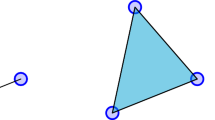Abstract
Persistent homology with coefficients in a field \(\mathbb {F}\) coincides with the same for cohomology because of duality. We propose an implementation of a recently introduced algorithm for persistent cohomology that attaches annotation vectors with the simplices. We separate the representation of the simplicial complex from the representation of the cohomology groups, and introduce a new data structure for maintaining the annotation matrix, which is more compact and reduces substantially the amount of matrix operations. In addition, we propose a heuristic to simplify further the representation of the cohomology groups and improve both time and space complexities. The paper provides a theoretical analysis, as well as a detailed experimental study of our implementation and comparison with state-of-the-art software for persistent homology and cohomology.




Similar content being viewed by others
Notes
PHAT also contains pivot column representations specifically optimized for \(\mathbb {Z}_2\) coefficients using low level bit operations. These bit representations usually accelerate by a constant factor the computation of persistence on complexes involving a lot of arithmetic operations, in particular the persistent homology algorithm PHAT on S4 and Kl in Fig. 3. They do not change the asymptotic analysis done in this paragraph.
References
Bauer, U., Kerber, M., Reininghaus, J.: PHAT. https://code.google.com/p/phat/ (2013)
Bauer, U., Kerber, M., Reininghaus, J.: Clear and compress: computing persistent homology in chunks. In: Topological Methods in Data Analysis and Visualization III, pp. 103–117 (2014)
Bauer, U., Kerber, M., Reininghaus, J., Wagner, H.: PHAT—persistent homology algorithms toolbox. In: Mathematical Software—ICMS 2014—4th International Congress, Seoul, South Korea, August 5–9, 2014. Proceedings, pp. 137–143 (2014)
Boissonnat, J.-D., Maria, C.: The simplex tree: an efficient data structure for general simplicial complexes. Algorithmica 70(3), 406–427 (2014)
Busaryev, O., Cabello, S., Chen, C., Dey, T.K., Wang, Y.: Annotating simplices with a homology basis and its applications. In: SWAT, pp. 189–200 (2012)
Chen, C., Kerber, M.: Persistent homology computation with a twist. In: Proceedings 27th European Workshop on Computational Geometry (2011)
Chen, C., Kerber, M.: An output-sensitive algorithm for persistent homology. Comput. Geom. 46(4), 435–447 (2013)
Cohen-Steiner, D., Edelsbrunner, H., Harer, J.: Stability of persistence diagrams. Discrete Comput. Geom. 37(1), 103–120 (2007)
de Silva, V., Morozov, D., Vejdemo-Johansson, M.: Dualities in persistent (co)homology. CoRR arXiv:1107.5665 (2011)
de Silva, V., Morozov, D., Vejdemo-Johansson, M.: Persistent cohomology and circular coordinates. Discrete Comput. Geom. 45(4), 737–759 (2011)
Dey, T.K., Fan, F., Wang, Y.: Computing topological persistence for simplicial maps. In: Symposium on Computational Geometry, p. 345 (2014)
Edelsbrunner, H., Harer, J.: Computational Topology—An Introduction. American Mathematical Society, Providence, RI (2010)
Edelsbrunner, H., Letscher, D., Zomorodian, A.: Topological persistence and simplification. Discrete Comput. Geom. 28(4), 511–533 (2002)
Maria, C.: Gudhi, Simplicial Complexes and Persistent Homology Packages. https://project.inria.fr/gudhi/software/
Maria, C., Boissonnat, J.-D., Glisse, M., Yvinec, M.: The Gudhi library: Simplicial complexes and persistent homology. In: International Congress on Mathematical Software, pp. 167–174 (2014)
Milosavljevic, N., Morozov, D., Skraba, P.: Zigzag persistent homology in matrix multiplication time. In: Symposium on Computational Geometry (2011)
Morozov, D.: Dionysus. http://www.mrzv.org/software/dionysus/
Morozov, D.: Persistence algorithm takes cubic time in worst case. In: BioGeometry News, Department of Computer Science, Duke University (2005)
Zomorodian, A., Carlsson, G.E.: Computing persistent homology. Discrete Comput. Geom. 33(2), 249–274 (2005)
Acknowledgments
This research is partially supported by the 7th Framework Programme for Research of the European Commission, under FET-Open Grant No. 255827 (CGL Computational Geometry Learning). This research is also partially supported by NSF (National Science Foundation, USA) Grants CCF-1048983 and CCF-1116258.
Author information
Authors and Affiliations
Corresponding author
Rights and permissions
About this article
Cite this article
Boissonnat, JD., Dey, T.K. & Maria, C. The Compressed Annotation Matrix: An Efficient Data Structure for Computing Persistent Cohomology. Algorithmica 73, 607–619 (2015). https://doi.org/10.1007/s00453-015-9999-4
Received:
Accepted:
Published:
Issue Date:
DOI: https://doi.org/10.1007/s00453-015-9999-4




